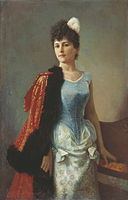 | ||
Died 6 February 1908, Saint Petersburg, Russia | ||
Carl Bogdanovich Wenig or, in German, Carl Gottlieb Wenig (Russian: Карл Богданович Вениг; 26 February 1830, Tallinn - 6 February 1908, Saint Petersburg) was a Baltic-German painter of historical and religious scenes. For many years, he was a Professor at the Imperial Academy of Arts.
Biography
His father, Gottlieb, was a music teacher and organist at St. Nicholas' Church. His mother, Agata, was an amateur painter and the aunt of Peter Carl Fabergé. From 1844 to 1853, he studied at the Imperial Academy of Arts with Fyodor Bruni. During his time there, he won several medals, including a gold medal for his depiction of Esther before Ahasuerus. Upon graduating, he was awarded a stipend that enabled him to continue his studies in Rome, where he remained for six years.
In 1860, he was awarded the title of "Academician" for his painting "The Entombment". Two years later, he was recognized as an Artist of Historical Painting on the strength of his depiction of two angels proclaiming the death of Sodom. He began to teach drawing at the Academy that same year.
In 1869, he became an Associate Professor and was promoted to a fully tenured Professor of the second-degree in 1876. He was advanced to the first-degree in 1888. After 1871, he served as a member of the Academy's governing board. In addition to his canvases, he created several decorative murals and icons at the Cathedral of Christ the Saviour.
His brothers, Bogdan and Pyotr (1849-1888) also became painters.
